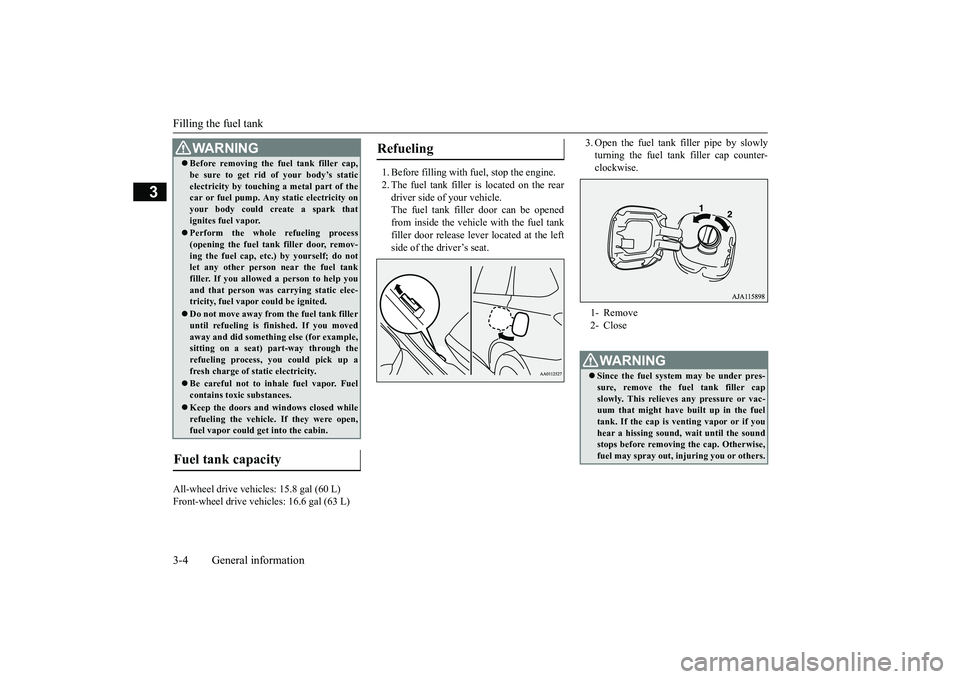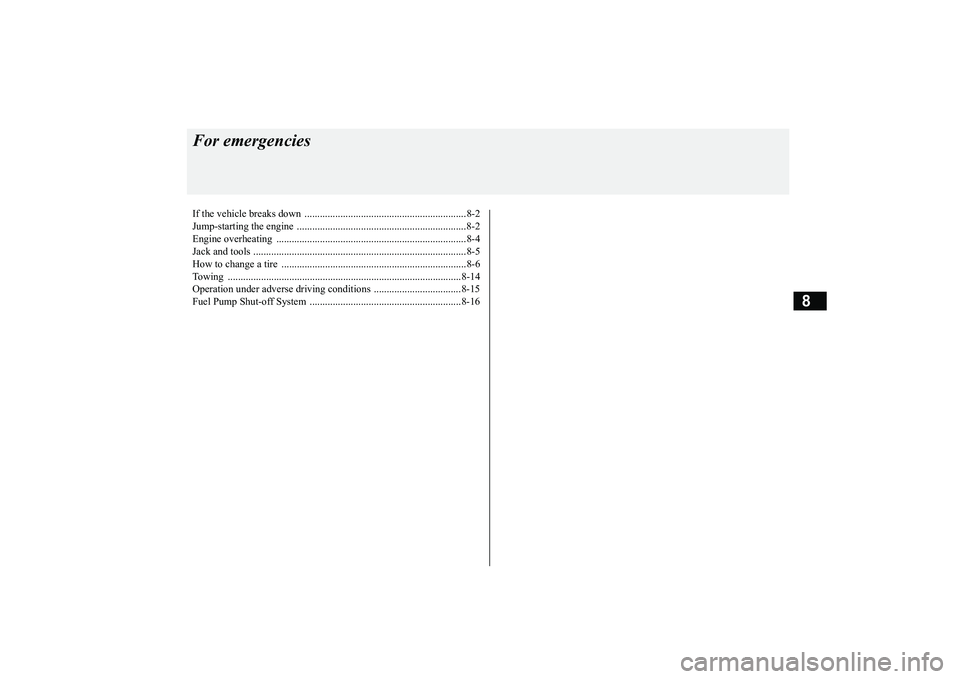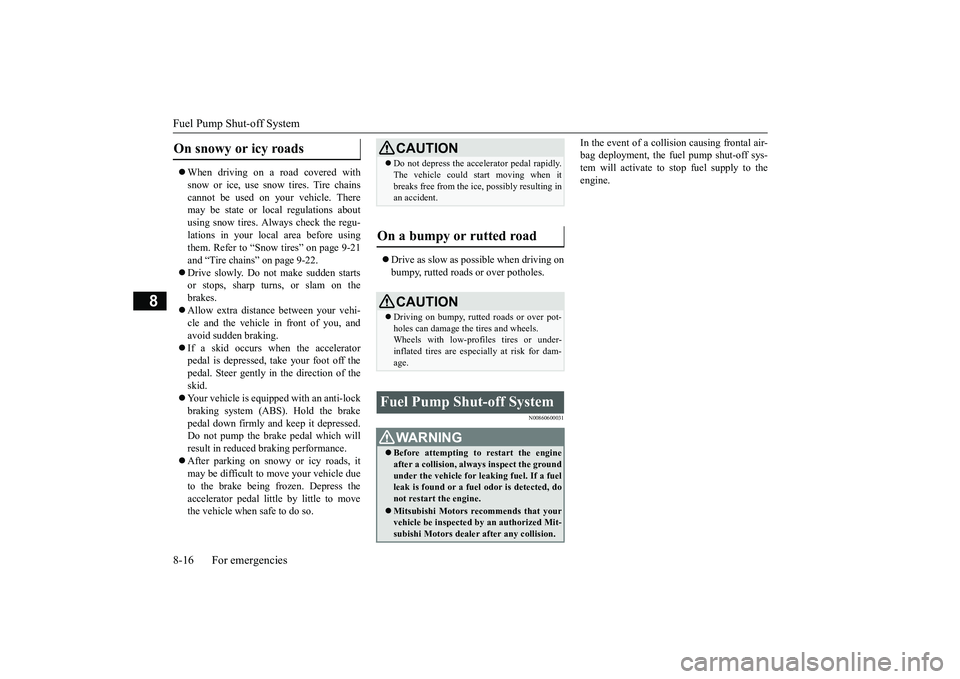2018 MITSUBISHI OUTLANDER III fuel pump
[x] Cancel search: fuel pumpPage 25 of 441

Filling the fuel tank3-4 General information
3
All-wheel drive vehicles: 15.8 gal (60 L)Front-wheel drive vehi
cles: 16.6 gal (63 L)
1. Before filling with fuel, stop the engine.2. The fuel tank filler is located on the reardriver side of your vehicle.The fuel tank filler door can be openedfrom inside the vehicle with the fuel tankfiller door release lever located at the leftside of the driver’s seat.
3. Open the fuel tank filler pipe by slowlyturning the fuel tank filler cap counter-clockwise.
Before removing the fuel tank filler cap,be sure to get rid of your body’s staticelectricity by touching a metal part of thecar or fuel pump. Any
static electricity on
your body could create a spark thatignites fuel vapor.Perform the whole
refueling process
(opening the fuel tank filler door, remov-ing the fuel cap, etc.) by yourself; do notlet any other
person near the fuel tank
filler. If you allowed
a person to help you
and that person was ca
rrying static elec-
tricity, fuel vapor could be ignited.Do not move away from
the fuel tank filler
until refueling is fi
nished. If you moved
away and did somethin
g else (for example,
sitting on a seat) part-way through therefueling process, you could pick up afresh charge of st
atic electricity.
Be careful not to inhale fuel vapor. Fuelcontains toxic substances.Keep the doors and wi
ndows closed while
refueling the vehicle. If they were open,fuel vapor could ge
t into the cabin.
Fuel tank capacity
WA R N I N G
Refueling
1- Remove2- CloseWA R N I N GSince the fuel system may be under pres-sure, remove the fuel tank filler capslowly. This relieves
any pressure or vac-
uum that might have built up in the fueltank. If the cap is venting vapor or if youhear a hissing sound, wait until the soundstops before removing the cap. Otherwise,fuel may spray out, in
juring you or others.
BK0249100US.book 4 ページ 2017年5月10日 水曜日 午前8時49分
Page 362 of 441

8
For emergenciesIf the vehicle breaks down ...............................................................8-2Jump-starting the engine ..................................................................8-2Engine overheating ..........................................................................8-4Jack and tools ...................................................................................8-5How to change a tire ........................................................................8-6Towing ...........................................................................................8-14Operation under adverse driving conditions
...........
.........
.........
.....8-15
Fuel Pump Shut-off System ...........................................................8-16
BK0249100US.book 1 ページ 2017年5月10日 水曜日 午前8時49分
Page 377 of 441

Fuel Pump Shut-off System8-16 For emergencies
8
When driving on a road covered withsnow or ice, use s
now tires. Tire chains
cannot be used on your vehicle. Theremay be state or local regulations aboutusing snow tires. Al
ways check the regu-
lations in your local area before usingthem. Refer to “Snow tires” on page 9-21and “Tire chains” on page 9-22.Drive slowly. Do not make sudden startsor stops, sharp turns, or slam on thebrakes.Allow extra distance
between your vehi-
cle and the vehicle in front of you, andavoid sudden braking.If a skid occurs when the acceleratorpedal is depressed, take your foot off thepedal. Steer gently in the direction of theskid.Your vehicle is equipped with an anti-lockbraking system (ABS). Hold the brakepedal down firmly and keep it depressed.Do not pump the brake pedal which willresult in reduced braking performance.After parking on snowy or icy roads, itmay be difficult to move your vehicle dueto the brake being frozen. Depress theaccelerator pedal little by little to movethe vehicle when safe to do so.
Drive as slow as pos
sible when driving on
bumpy, rutted roads or over potholes.
N00860600031
In the event of a collision causing frontal air-bag deployment, the fuel pump shut-off sys-tem will activate to st
op fuel supply to the
engine.
On snowy or icy roads
CAUTIONDo not depress the acce
lerator pedal rapidly.
The vehicle could start moving when itbreaks free from the
ice, possibly resulting in
an accident.
On a bumpy or rutted road
CAUTIONDriving on bumpy, rutted roads or over pot-holes can damage th
e tires and wheels.
Wheels with low-profiles tires or under-inflated tires are especially at risk for dam-age.
Fuel Pump Shut-off System
WA R N I N GBefore attempting to restart the engineafter a collision, alw
ays inspect the ground
under the vehicle for leaking fuel. If a fuelleak is found or a fuel
odor is detected, do
not restart the engine.Mitsubishi Motors recommends that yourvehicle be inspected by
an author
ized Mit-
subishi Motors dealer
after any collision.
BK0249100US.book 16 ページ 2017年5月10日 水曜日 午前8時49分
Page 406 of 441

Fuses
Vehicle care and maintenance 9-29
9
*: Fusible link
SBF2 Starter 30 A*SBF3
Air condition-ing condenser fan motor
30 A*
SBF4
Radiator fan
motor
40 A*
SBF5
Anti-lock brak-ing system
40 A*
SBF6
Electric parking
brake
50 A*
SBF7
Anti-lock brak-ing system
30 A*
BF1 Power liftgate 30 ABF2
Audio system amplifier
30 A
BF3 IOD IOD 30 ABF4 Diesel 30 AF1
Automatic transaxle
20 A
F2 Wiper de-icer 15AF3
Electric parking
brake
7.5 A
F4
Daytime run-ning lights
10 A
No.
Sym-bol
Electrical sys-
tem
Capacity
F5 Front fog lights 15 AF6 Air conditioner 10 AF7
Headlight washer
20 A
F8 Security horn 20 AF9 Horn 10 AF10 ETV 15 AF11 Alternator 7.5 AF12 Engine 7.5 AF13
ENG/POWER 20 AFuel line heater 25 A
F14 Fuel pump 15 AF15 Ignition coil 10 AF16 ENG/POWER 10 AF17
Headlight (high beam) (left)
10 A
F18
Headlight (high beam) (right)
10 A
No.
Sym-bol
Electrical sys-
tem
Capacity
F19
Head-light (low beam) (left)
LED 20 A
F20
Head-light (low beam) (right)
LED 20 A
F21
Head-light (low beam) (left)
Halo-gen
10 A
F22
Head-light (low beam) (right)
Halo-gen
10 A
F23
Battery current
sensor
7.5 A
#1 — Spare fuse 10 A#2 — Spare fuse 15 A#3 — Spare fuse 20 ANo.
Sym-bol
Electrical sys-
tem
Capacity
BK0249100US.book 29 ページ 2017年5月10日 水曜日 午前8時49分
Page 438 of 441

Alphabetical index
12-3
12
Fuel hoses
......................................
9-23
Fuel selection
...................................
3-2
Tank capacity
.................................
11-7
Fuel Pump Shut-off System
.................
8-16
Fuses
.................................................
9-26
Fusible links
.......................................
9-25
G
General maintenance
...........................
9-24
General vehicle data
............................
11-4
Genuine parts
.......................................
3-7
Glove compartment
...........................
5-239
Glove compartment light
Bulb capacity
.................................
9-33
H
Hazard warning
flasher switch
...........
5-218
Hazard warning lights
.......................
5-202
Head restraints
....................................
4-11
Headlight leveling switch
..................
5-216
Headlights
Bulb capacity
.................................
9-32
Dimmer
.......................................
5-210
Headlight flasher
..........................
5-211
Replacement
.........................
9-34
, 9-35
Switch
.........................................
5-207
Heated steering wheel switch
.............
5-226
High beam indicator
..........................
5-202
High-mounted stop light
Bulb capacity
.................................
9-32
Hill start assist
...................................
5-95
HomeLink® Wireless
Control System
.5-231
Hood lock release me
chanism and safety
catch
...............................................
9-25
Horn switch
......................................
5-227
I
If the vehicle breaks down
.....................
8-2
Ignition switch
...................................
5-63
Important facts to know in
case of an accident
10-4Indicators
....................
5-181
, 5-201
, 5-202
Information screen display
.................
5-182
Inside rearview mirror
.........................
5-57
Inspection and maintena
nce following rough
road operation
..................................
5-91
Instrument cluster
..............................
5-154
Interior lights
....................................
5-236
J
Jack
....................................................
8-5
Storage
............................................
8-5
Jump-starting the engine
.......................
8-2
K
Keyless entry system
....................
5-7
, 5-30
Keys
....................................................
5-3
L
Labeling
.............................................
11-2
Lane Departure Warning System (LDW)
.....
5-134License plate light
Bulb capacity
.................................
9-32
Replacement
...................................
9-39
Liftgate
..............................................
5-38
Link System
.....................................
5-227
Loading information
..............................
6-6
Lubricants
..........................................
11-7
Luggage floor box
.............................
5-240
Luggage hooks
.................................
5-246
M
MIVEC engine
..........................
5-26
, 5-67
Modification of your vehicle
..................
3-5
Multi Around Monitor
.......................
5-144
Multi information display - Type 1
.....
5-155
Multi information display - Type 2
.....
5-173
BK0249100US.book 3 ページ 2017年5月10日 水曜日 午前8時49分